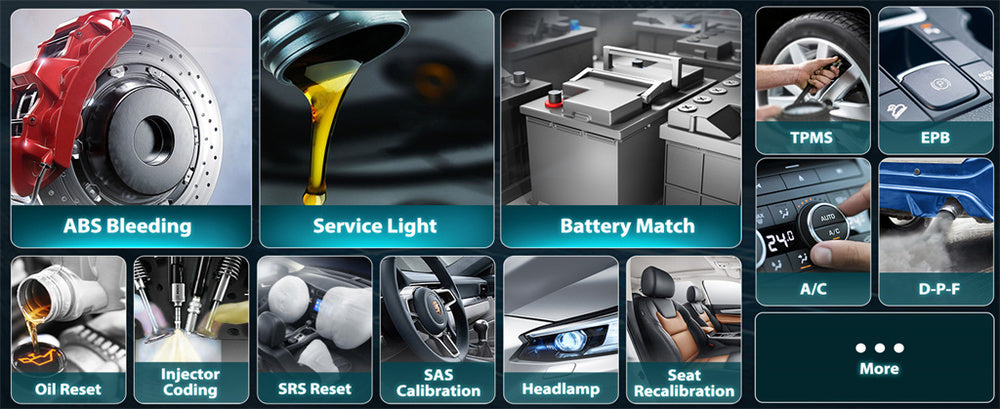In modern vehicles, the ECU is essentially the car’s brain, managing everything from engine performance to system diagnostics.
When it malfunctions, it can cause a wide array of problems, from decreased fuel efficiency to complete engine shutdowns.
Fortunately, tools like the OBD2 Scanner make diagnosing and preventing these issues much easier.
This article explores the common causes of ECU failure and how using an advanced scanner like the Foxwell NT1009 can help you identify and fix problems before they become costly repairs.
The Role of the ECU and Benefits of Using OBD2 Scanners

The ECU in your car is essentially the central computer that manages and controls various systems, such as fuel injection, ignition timing, and even air conditioning.
In modern vehicles, it’s not just one ECU but sometimes multiple units, each overseeing specific systems like engine control (ECM) or transmission control (TCM).
But like any other computer, ECUs can experience failures, leading to a range of issues like reduced engine performance, poor fuel economy, or even total engine failure. When the ECU malfunctions, the vehicle's ability to manage key systems deteriorates.
This is where an OBD2 Scanner becomes invaluable. By plugging into the OBD2 port, the scanner communicates with the ECU, reading error codes (like the infamous P0300 for random misfires) and providing insight into what's wrong.
This information is critical for pinpointing issues before they escalate, especially for car owners who prefer to address problems early.
Electrical Surges: Detecting Damage with OBD2 Scanners
One of the most common killers of an ECU is an electrical surge. The ECU operates on a stable voltage, typically 12 volts. However, sudden voltage spikes—caused by a failing alternator or an improper jump-start—can fry the delicate internal components of the ECU, leading to immediate failure or gradual deterioration.
Symptoms of electrical surge damage might include:
- Erratic engine behavior (sudden power loss or surges).
- Unresponsive sensors (like oxygen or throttle position sensors).
- Blinking or irregular dashboard lights.
The OBD2 Scanner can detect anomalies in voltage regulation by reading codes related to electrical system failures. For example, it might throw a code like P0562 (low system voltage) or U1000 (communication error between modules), giving you a clue about the problem's source. Once flagged, you can investigate the alternator, battery connections, or ground wiring, preventing the ECU from further damage.
Water Damage: How OBD2 Scanners Can Help
Unlike your smartphone, your car's ECU isn’t waterproof. Water damage to the ECU is a nightmare, especially for cars exposed to heavy rain, flooding, or poor sealing in the engine bay. Water can short-circuit the electronic components within the ECU, leading to corrosion and eventual failure.
Signs that water might have affected your ECU include:
- Engine stalling or misfires.
- Unusual sensor readings (especially in areas like the intake or exhaust).
- Intermittent loss of power or difficulty starting.
An OBD2 Scanner can provide early warnings of water damage by detecting sensor malfunctions or communication errors with the ECU. For instance, a P0600 (serial communication link malfunction) or a P2100 (throttle actuator control motor circuit) may suggest that moisture has compromised specific circuits within the ECU.
If you suspect water damage, acting quickly is key. Depending on the extent of the exposure, the ECU might need drying and resealing, or in severe cases, replacement. Preventative measures include regularly inspecting seals around the engine bay and avoiding deep water when driving.
ECU Wear and Tear: Monitoring with OBD2 Scanners
Just like every other component in your car, ECUs wear out over time. Even though they are designed to last for years, constant exposure to heat, vibrations, and electrical loads can cause gradual degradation of the internal components.
Typical signs of ECU aging include:
- Increased fuel consumption or inefficient engine performance.
- Lag or delay in sensor responses (e.g., from the oxygen sensor or knock sensor).
- Hard starting or inability to maintain a smooth idle.
Wear and tear might not show up overnight, but an OBD2 Scanner can help monitor the health of the ECU by consistently tracking performance-related issues. Codes like P0171 (system too lean) or P0420 (catalyst system efficiency below threshold) can point to sensors not being controlled effectively by the ECU, hinting at the need for recalibration or replacement.
Regular maintenance checks using an OBD2 scanner help ensure the ECU doesn’t fail unexpectedly, especially after years of use. It’s a good practice to monitor your ECU for any signs of underperformance, which can prevent costly repairs down the line.
Software Issues: Identifying Faults via OBD2 Scanners
As vehicles become more computerized, software problems within the ECU are becoming increasingly common. Bugs or corrupt updates can cause the ECU to misinterpret data from sensors, leading to incorrect adjustments in air-fuel ratios, ignition timing, or throttle control.
Symptoms of ECU software issues include:
- Random engine shut-offs or failure to start.
- Unexpected warning lights (such as the check engine light) without any clear cause.
- Poor acceleration or shifting irregularities.
The OBD2 Scanner plays a critical role in detecting software-related issues. A common code for software problems is P0601 (internal control module memory check sum error), indicating that the ECU is failing its self-test due to corrupted programming.
In many cases, re-flashing (updating) the ECU’s software can solve these issues. Manufacturers often release updates that fix known software glitches, and some mechanics or dealerships can perform these re-flashes to restore ECU performance.
Faulty Wiring: Diagnosing with OBD2 Scanners
The ECU relies on a network of wires to communicate with the car’s various sensors and actuators. Over time, these wires can degrade, become loose, or even short-circuit. Faulty wiring is a particularly tricky problem because it can cause intermittent issues, making it difficult to diagnose without the right tools.
Some common signs of faulty wiring include:
- Sensors going offline sporadically.
- Dashboard lights flickering or coming on without reason.
- ECU communication errors.
Using an OBD2 Scanner, you can identify the specific modules or sensors that are failing to communicate with the ECU. Codes like U0100 (lost communication with ECM) or P2140 (circuit problems) indicate wiring issues, allowing you to trace the problem back to its source.
Inspecting the car's wiring harnesses for damaged or frayed wires, and ensuring that all connections are secure, can prevent more serious ECU problems caused by poor communication.
Prevention Tips to Extend ECU Life with OBD2 Support
Maintaining your ECU in peak condition doesn’t require a degree in electrical engineering—it just requires some good habits and an OBD2 Scanner. Here’s how you can keep your ECU happy and healthy for as long as possible:
Perform Regular Scans: Periodically use your OBD2 scanner to check for error codes, even if no dashboard lights are on. Early detection of small issues can prevent big repairs.
Avoid Jump-Starting Improperly: Incorrect jump-starting is one of the leading causes of ECU damage. Always double-check your connections, or better yet, use a portable jump-starter with built-in surge protection.
Protect Your Car from Water: Keep your car dry, particularly in areas where water can seep into the ECU. Waterproofing the ECU with special enclosures or even relocating it can help in flood-prone areas.
Stay Up-to-Date on Software: Regular software updates are important. Your dealership or trusted mechanic should be able to check for any ECU software updates that improve functionality or fix bugs.
Monitor Wiring: Frequently inspect your car’s wiring harnesses and connections, particularly if your vehicle experiences rough terrain or high vibration. This helps prevent short circuits or communication failures between the ECU and sensors.
By taking these steps and consistently using an OBD2 scanner, you’ll catch small issues before they become expensive problems and extend the lifespan of your ECU.
When to Seek Help and Use OBD2 Insights
While OBD2 scanners can give you insight into the health of your ECU, sometimes the problems require more expertise than DIY fixes can provide.
If your scanner continues to show error codes despite your efforts, or if the codes indicate severe internal ECU damage, it’s time to consult a professional.
Armed with the insights from your OBD2 scanner, you’ll have a clearer understanding of what’s wrong, helping you communicate effectively with a mechanic.
This not only saves diagnostic time but also ensures that the mechanic can go straight to the root of the problem.

Recommended Tool for ECU Diagnostics: Foxwell NT1009
When it comes to diagnosing and resolving ECU-related issues, the Foxwell NT1009 is a standout tool that every car enthusiast or professional mechanic should consider.
It offers comprehensive diagnostic capabilities, including ECU coding, which is crucial when dealing with ECU replacements or resets.
One of the best features of the Foxwell NT1009 is its bidirectional control, allowing users to interact with various vehicle components, including the ECU, to test functions, perform resets, and even reprogram parts of the system after repair.
This tool supports more than 34 reset services (like battery configuration, throttle learning, and injector coding), making it ideal for both regular maintenance and more complex fixes.
Additionally, its ECU coding feature is particularly valuable for those who need to adapt new components after a repair.
Whether you’re installing a new ECU or resetting the existing one, the NT1009 simplifies the process with adaptive learning capabilities. It's especially useful for vehicle makes such as BMW, Hyundai, and Honda, where the ECU requires frequent coding updates for optimal performance.
The Foxwell NT1009 also supports real-time data streaming and advanced diagnostics across various systems in the vehicle, making it a great all-in-one tool for ECU maintenance.
If you're dealing with issues like communication failures or sensor malfunctions, this tool provides precise data to guide your repairs and prevent unnecessary part replacements.
For anyone facing recurrent ECU problems or simply looking to maintain their vehicle's health more effectively, the Foxwell NT1009 offers a robust, user-friendly solution.
With features like offline ECU coding and intelligent system diagnostics, this scanner empowers you to keep your car's ECU running smoothly while minimizing repair costs.
Conclusion
The ECU is the nerve center of your car, and when it malfunctions, it can lead to a range of complex issues.
By understanding the common causes of ECU failure, such as electrical surges, water damage, and software glitches, you can take preventative measures to protect your car's brain.
Regular use of an OBD2 Scanner is your best tool for diagnosing and preventing these problems before they become more serious.
With the right maintenance habits and a proactive approach to monitoring your car’s systems, you can ensure that your ECU—and your car—stays in top shape for years to come.
FAQs
What is the most common failure of an ECM?
The most common failure of an ECM (Engine Control Module) is wiring issues or faulty sensors. These cause improper communication between the ECM and other vehicle systems, leading to erratic engine behavior or failure to start.
What can damage an ECU on a car?
Several factors can damage an ECU, including electrical surges, water ingress, and wear and tear over time. Other causes include faulty wiring, extreme temperatures, and software corruption.
Can a bad ECU be reset?
Yes, a bad ECU can often be reset, especially if the issue stems from software glitches or minor errors. However, if the ECU has physical damage, resetting might not resolve the problem, and replacement could be necessary.




Leave a comment
This site is protected by hCaptcha and the hCaptcha Privacy Policy and Terms of Service apply.